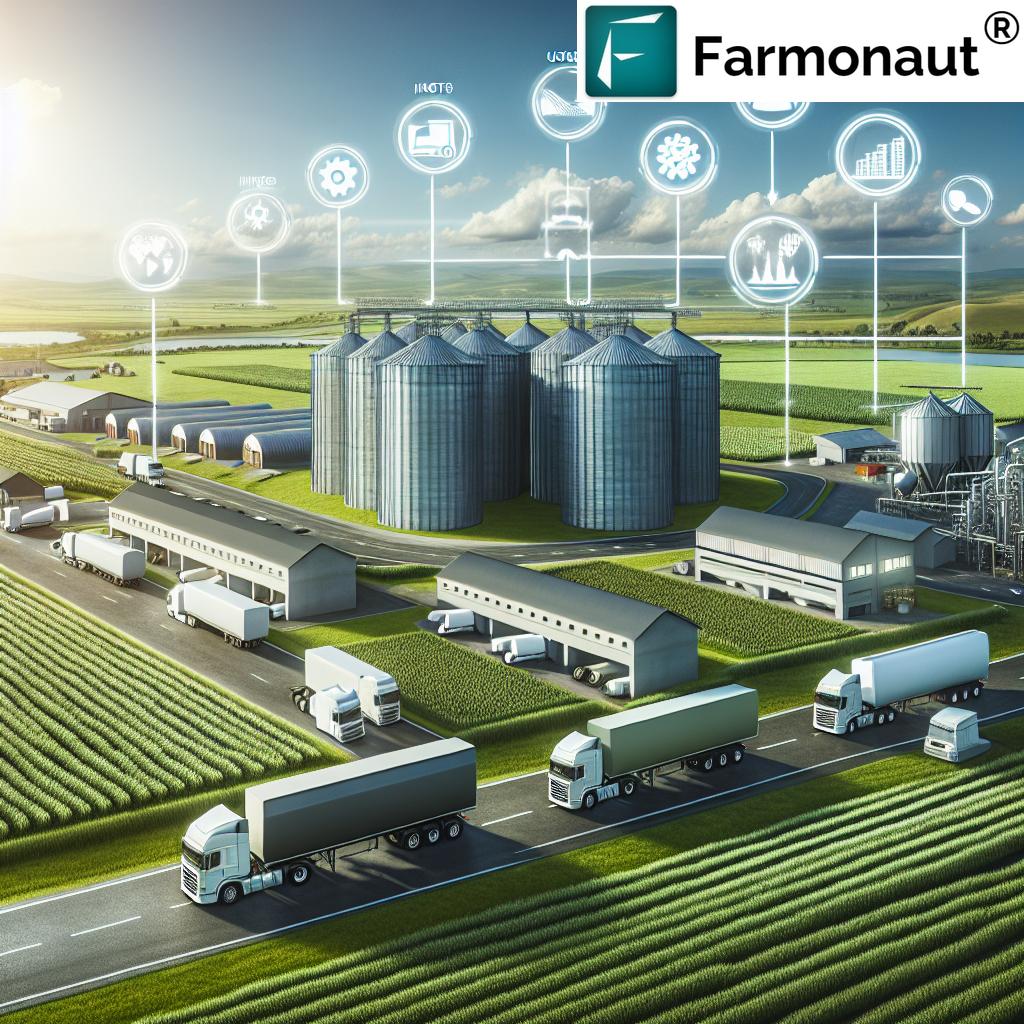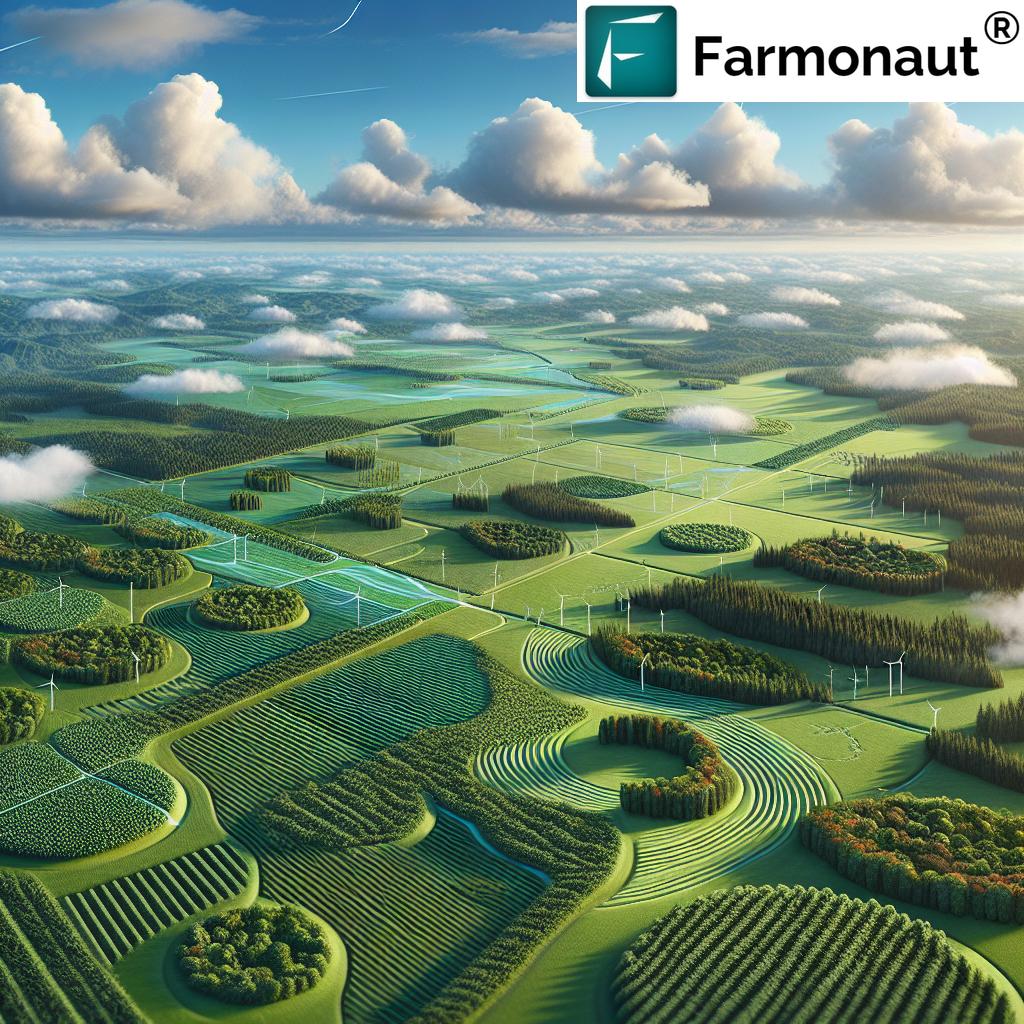Progressive Agriculture: 5 Key Tech Trends for 2025
Table of Contents
- Understanding Progressive Agriculture in 2025
- The Role of Partnerships in Progressive Agriculture
- Key Challenges and Opportunities in 2025
- 5 Key Tech Trends Revolutionizing Progressive Agriculture for 2025
- Comparison Table of Key Tech Trends in Progressive Agriculture (2025)
- Farmonaut: Enabling Progressive Agriculture with Satellite-Driven Insights
- Future Opportunities & Pathways for Progression Agriculture
- Frequently Asked Questions
Summary: Partnerships for Progressive Agriculture: Driving Technological Progress in 2025
As our global population surges toward 9 billion by 2030, the imperative to enhance agricultural productivity, sustainability, and food security has never been more urgent. Progressive agriculture, also known as progressive farming or progression agriculture, represents a paradigm shift: integrating advanced technologies, innovative practices, and synergistic partnerships to address 21st-century challenges, from climate change to economic viability.
In 2025, the concept of “partnership for progressive agriculture” emerges as a critical catalyst for technological progress in agriculture. Through AI, IoT, precision farming, blockchain, and more, we witness a sweeping transformation—optimizing yields, resource use, and sustainability worldwide. Yet, the story is not simply technological; it’s collaborative. A shared vision among farmers, businesses, governments, and technology providers propels us toward a food-secure, economically resilient, and environmentally responsible agricultural future.
Understanding Progressive Agriculture in 2025
Progressive agriculture (or progressive farming) is characterized by the integration of advanced agricultural technologies and data-driven practices which transcend traditional methods. This transformation is not only about adopting technology, but also about rethinking approaches to agricultural productivity, sustainability, and food security. In 2025, progression agriculture encompasses the following pillars:
- Advanced Technologies: Embracing AI, drone surveillance, the Internet of Things (IoT), biotechnology, blockchain, and other digital innovations.
- Optimized Resource Use: Implementing tools and strategies to enhance crop yields, reduce waste, and conserve natural resources such as water and soil nutrients.
- Data-Driven Decision Making: Leveraging real-time data for informed management of crops, resources, and environmental impacts.
- Collaborative Models: The realization that technology alone cannot drive transformation; partnerships among farmers, agricultural businesses, research institutions, governments, and technology providers are essential for progress.
Such a synergistic approach places progressive agriculture at the forefront of 2025’s global food production, addressing the rising demand from our expanding population, changing climate, and evolving consumer preferences. It creates a pathway that is economically viable, environmentally sustainable, and socially inclusive.
The Role of Partnerships in Progressive Agriculture
Partnerships have become central to realizing technological progress in agriculture in 2025. The concept of “partnership for progressive agriculture” is the critical catalyst for accelerating innovation, yielding higher productivity, and ensuring sustainability worldwide. Here’s how:
- Knowledge Sharing & Innovation Diffusion: Collaborative approaches foster shared knowledge and pooled resources, enabling even smallholder farmers and local cooperatives to access leading-edge tools and practices.
- Accessible Technology: Public-private partnerships (PPPs) and government subsidies play a crucial role in deploying technologies such as AI-powered weather prediction tools, mobile-based precision farming platforms, and sustainable irrigation systems.
- Financing & Risk Mitigation: Progressive agriculture often requires upfront investments in technologies that can be prohibitive for individual farmers. Microfinancing and risk-sharing mechanisms bridge the gap, enabling all farmers, regardless of scale, to benefit.
- Inclusivity and Social Sustainability: These models create opportunities for women, youth, and underserved communities, ensuring that the progress benefits all contributors to the food system.
Through these collaborative partnerships, progressive agriculture is not just about technology; it’s about making that technology accessible, scalable, and effective for diverse farmers and geographies worldwide.
Key Challenges and Opportunities in 2025
While the progressive agriculture movement is gaining rapid momentum, several challenges remain, particularly for smallholder and resource-constrained farmers. Recognizing and addressing these gaps is essential for sustainable, inclusive progress.
Main Challenges
- Limited Access to Technology: Infrastructure, knowledge, or affordability barriers.
- Digital Literacy Gaps: The need for training, local language support, and tailored advisory services.
- Environmental Volatility: Climate unpredictability, water scarcity, and new pest or disease pressures.
- Resource Constraints: Upfront investment for equipment, systems, and sensor networks can be prohibitive for individuals.
- Data Security and Privacy: Safe management of sensitive farm data and transparency in digital platforms.
Emerging Opportunities
- Mobile Platforms & APIs: Remote access extends the reach of progressive farming tools to rural and global regions. Farmonaut’s app exemplifies satellite agriculture platforms driving local access.
- Sustainable Finance: Models such as satellite-based verification for crop loans and insurance reduce fraud and open vital financing. View crop loan and insurance benefits here.
- Inclusivity Through Collaboration: Partnerships and extension services promote digital literacy and capacity building among farmers everywhere.
- Localized Solutions: AI models and sensor networks tailored to local conditions (soils, climate, crops) optimize yields and reduce waste.
5 Key Tech Trends Revolutionizing Progressive Agriculture for 2025
The driving force behind progressive farming and progression agriculture in 2025 is the integration of five transformative technology trends. Each trend emphasizes advanced technology adoption, sustainability, resource optimization, and boosting agricultural productivity for farmers worldwide. Let’s explore each in detail:
1. Artificial Intelligence (AI) & Data Analytics in Agriculture
- Role: AI algorithms analyze massive datasets from satellite imagery, drones, and IoT sensors, producing actionable insights for crop health, soil fertility, irrigation, weather prediction, and pest management.
-
Key Benefits:
- Real-time weather prediction and risk mitigation
- Site-specific nutrient and water management
- Yield forecasting models that improve financial planning
- Tailored recommendations—improving efficiency, reducing waste
- Adoption Example: AI-integration via mobile or web platforms enables even smallholder farmers to receive daily, AI-driven advisories. Check out large scale farm management AI tools.
2. Internet of Things (IoT) & Smart Farming Systems
- Role: IoT sensors monitor soil moisture, temperature, crop growth stages, and environmental conditions.
-
Key Benefits:
- Automated irrigation and fertilization systems
- Reduced labor costs via remote management
- Early detection of crop stress, pests, or water shortages
- Sustainability through resource-efficient practices
- Access: IoT-powered apps and platforms, such as those provided by Farmonaut’s satellite monitoring app, empower farmers globally.
3. Precision Farming Tools & Platforms
- Role: Precision agriculture tools enable targeted seeding, irrigation, fertilization, and pesticide applications at a micro (plant-by-plant) level.
-
Key Benefits:
- Reduced use of agrochemicals; fewer environmental impacts
- Boosted yield quality and quantity
- Cost savings and improved resource efficiency
- Climate-adaptive practices for water conservation
- Access: Platforms like Farmonaut offer precision monitoring via carbon footprint tracking to encourage sustainable practices.
4. Drones, Satellite Imaging & Surveillance
- Role: Drones and satellites capture high-resolution images to monitor crop health, identify disease or pest outbreaks, and assess water/soil variation in large fields.
-
Key Benefits:
- Rapid, large-scale field surveillance without manual labor
- Early threat detection prevents loss and mitigates risk
- Data-driven advisories for intervention and input application
- Track carbon emissions and environmental impacts continuously
- Access: Satellite-driven intelligence, such as that delivered through blockchain-based traceability, enhances transparency and trust in supply chains.
5. Automated Machinery & Robotics
- Role: Autonomous tractors, robotic harvesters, and automated planting systems streamline operations, especially on a large or commercial farming scale.
-
Key Benefits:
- Increased scale of production with less manual labor
- Consistency and accuracy in field tasks
- Lower costs per unit of output; greater profitability
- Safer working conditions and reduced repetitive strain on workers
- Access: Technology monitoring tools, like Farmonaut’s fleet management system, optimize equipment and logistics for greater efficiency.
Comparison Table of Key Tech Trends in Progressive Agriculture (2025)
| Technology | Main Application | Estimated 2025 Adoption Rate (%) | Projected Yield Increase (%) | Sustainability Impact | Role of Partnerships |
|---|---|---|---|---|---|
| AI & Machine Learning | Data analytics, yield forecasting, smart advisory | 55-65% | Up to 20% | Reduced chemical use, efficient resources | Knowledge sharing, joint tool development |
| IoT Sensors | Field monitoring, automated irrigation/fertilization | 45-55% | 12-18% | Water/energy conservation, lower emissions | Deployment support, cross-industry APIs |
| Precision Farming Tools | Targeted input application, micro-management | 60-75% | 16-22% | Minimized waste, eco-friendly operations | Finance facilitation, farmer training |
| Drones & Imaging | Remote crop monitoring, disease/pest scouting | 30-45% | 8-14% | Early intervention, reduced losses | Platform access, image processing resources |
| Automated Machinery | Autonomous planting, spraying, harvesting | 40-52% | 9-15% | Lower fuel use, safer work, less labor | Financing models, multi-farm deployment |
Farmonaut: Enabling Progressive Agriculture with Satellite-Driven Insights
As the agricultural landscape rapidly evolves in 2025, the integration of satellite technology, AI, and blockchain is becoming indispensable for progressive agriculture. That’s where our work at Farmonaut comes in. Let’s explore how Farmonaut is empowering progressive farming with affordable, accessible, and advanced technology:
- Satellite-Based Monitoring: We provide multispectral satellite imagery for real-time monitoring of crop health (using NDVI), soil conditions, and resource management at scale. Our mobile and web platforms provide instant, actionable insights for farmers, agribusinesses, and government institutions worldwide.
- Jeevn AI Advisory System: Our AI-driven system synthesizes satellite and ground data to deliver tailored agricultural advice, including yield forecasts, weather alerts, and strategic interventions. This empowers smart decision-making for both smallholders and commercial producers.
- Blockchain-Based Traceability: With demand for transparency increasing, our platforms ensure full batch traceability for agricultural products. This combats food fraud and builds trust in sustainability claims. Learn more about product traceability solutions.
- Environmental Impact & Carbon Footprint Monitoring: We enable farmers and businesses to track carbon emissions, water usage, and overall environmental impact, promoting sustainable progression agriculture. Discover our carbon footprinting platform.
- Fleet and Resource Management: Our logistics and fleet management tools help businesses in agriculture optimize machinery and vehicle usage, cutting operational costs and emissions. See our fleet management system.
- API Access & Developer Tools: Developers and agribusinesses can rapidly integrate satellite-powered analytics into their workflows. Check our API and API developer documentation.
- Affordable and Scalable: We offer a modular, subscription-based pricing model with options for individuals, businesses, and governments. Flexible, scalable, and cost-efficient. Subscribe below:
Our platform is accessible anywhere via web, Android, and iOS apps.
Start harnessing satellite intelligence for progressive agriculture today!
Future Opportunities & Pathways for Progression Agriculture
The future of progressive agriculture in 2025 and beyond lies in the accelerated adoption of integrated, digital and intelligent technologies. As we approach a world with nearly 9 billion people, the following strategic opportunities emerge:
- Scaling Precision and AI: Combining deep learning models, satellite imagery, and field-level sensors will refine site-specific management—maximizing yields and minimizing resource waste.
- Carbon Footprinting for Sustainability: Adopting digital carbon footprint monitoring will become standard for compliance, branding, and sustainable practices.
- Global Connectivity: Enhanced mobile platforms and cloud-based APIs will break down geographic barriers, enabling real-time advisory and traceability from field to fork.
- Inclusivity—Women and Youth: Focused training, accessible technology, and digital cooperatives are crucial for social sustainability and innovation.
- Transparent Supply Chains: Increasing adoption of blockchain traceability platforms like Farmonaut’s solution will boost consumer trust and encourage best practices globally.
- Financial Access: Satellite-backed crop loan and insurance models will be instrumental for smallholders to adopt technologies rapidly.
Frequently Asked Questions (FAQ) – Progressive Agriculture 2025
-
What is progressive agriculture?
Progressive agriculture, or progressive farming, refers to the adoption of advanced technologies and data-driven practices (like AI, IoT, precision tools, and blockchain) in agriculture, aimed at optimizing crop yields, sustainability, and overall efficiency. -
How does AI improve agricultural productivity?
AI and machine learning analyze vast datasets—such as satellite imagery, soil health, and weather data—to provide insights that enable farmers to manage crops more precisely, reduce inputs, and increase yields by up to 20% in 2025. -
What role does the IoT play in progression agriculture?
IoT sensors continuously monitor soil, climate, and plant status, automating systems like irrigation and fertilization. This real-time intelligence reduces labor, conserves resources, and increases yield consistency. -
How do blockchain-based traceability systems benefit farmers?
Blockchain ensures transparency and security from farm to consumer, enabling reliable certification, reducing food fraud, and encouraging sustainable practices. View traceability benefits. -
Is Farmonaut an equipment manufacturer or regulatory body?
No. Farmonaut is a satellite technology provider—offering data-driven solutions through platforms, APIs, and applications for monitoring, advisory, traceability, and resource management in agriculture and allied sectors. -
Can smallholder and local farmers access these technologies?
Absolutely. With affordable, app-based platforms such as Farmonaut’s mobile/web app, even small-scale and local users can leverage progressive agriculture tools without large infrastructure investment. -
How will progressive agriculture evolve after 2025?
We will see even deeper AI integration, wider blockchain adoption, ubiquitous sensor connectivity, and increased global emphasis on sustainability, inclusivity, and transparency for all actors in the agricultural value chain.
Conclusion
In 2025, the intersection of technological progress and strategic approaches like progressive farming is reshaping the agricultural world. From AI and IoT to satellite-driven platforms, blockchain transparency, and precision tools, the future of sustainable agriculture is here—accessible, globally connected, and relentlessly innovative.
As food demands soar and climate pressures intensify, an unwavering focus on advanced technology integration, accessible digital platforms, and collaborative approaches will ensure food security, environmental stewardship, and economic viability for farmers worldwide. The journey of progressive agriculture is just beginning—and with the right knowledge and digital resources, we can boost yields, optimize resources, and build a sustainable agricultural future for billions.
For further exploration of progressive agriculture, climate-smart solutions, and advanced agricultural technologies for 2025 and beyond, bookmark this blog and connect with leading-edge platforms shaping the future of food and farming.











